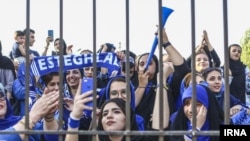Last week, two women from the Middle East made international news. One was 33-year-old Mashael al-Jaloud of Saudi Arabia, who ditched the traditional abaya and walked around town hijab-free in a red jacket, turning heads and sparking conversation.
The other was Sahar Khodayari, 29, a soccer fan from Iran who decided to burn herself upon being informed of her impending jail sentence for the “crime” of entering an athletic stadium; she died last week as a result of her injuries. Against the backdrop of Iran’s widespread anti-hijab movement, known as White Wednesdays, Sahar Khodayari is being memorialized as the #bluegirl while Saudi Arabia’s Mashael al-Jaloud is being recognized as the ‘woman in red.’
Saudi Arabia is far from a haven for women’s rights and the moments of freedom and progress are inconsistent. While Mashael al-Jaloud can walk freely in a crowd of black-veiled women, 30 year old, Loujain al-Hathloul remains in jail for defying Saudi driving rules before they were overturned.
However, in a conversation about women’s rights, it seems increasingly hypocritical to criticize the treatment of women in the Saudi Kingdom without being honest about Iran. First, these countries don’t share the same starting point for their struggles. Second, their governments are taking different roles in implementing solutions.
In Saudi Arabia, the government is driving a newfound agenda of openness, whereas the Iranian regime appears committed to a throwback agenda of apartheid.
For the past 40 years in Iran, religious laws have been used as justification to relegate women to second-class citizenship. This issue has attracted far less attention than the situation in Saudi Arabia, in part because some have dismissed these practices as ‘cultural issues.’ However, these laws have enabled gender apartheid in Iran, a carefully constructed system that intentionally reduces women to second-class citizens simply because of their gender. While we see some degree of liberalization in Saudi Arabia, some experts see an intensification of women’s repression in Iran.
Whereas repressive religious laws have been commonplace in Saudi Arabia for centuries, one can trace the origin of women’s repression in Iran to a specific moment in recent history: the Islamic Revolution in 1979. It was a sudden and abrupt transformation of cultural practices and women’s social status.
In the ‘60s and ‘70s, women in Iran dressed however they wished, from European-inspired fashions and bikinis to modest scarves and black veils. All that changed with the revolution. With the onset of the ‘80s, women found themselves living in a backwards reality that forced them to remove their nail polish and makeup, to shroud their hair and bodies in dark colors, and to forego perfume or other cosmetics. Instead, all women – regardless of religion or degree of observance –were commanded to wear the hijab and surrender their self-determination and sense of personal identity. Since 1990s women have pushed back and regained their freedom to wear makeup, but most of restrictions remain in place.
But the hijab was not the end of it; in fact, it was only the beginning of their demotion to second-class citizenship. Under new laws, women were increasingly socially isolated and legally forced to depend on men for mundane but essential decisions involving employment, travel, education, and marriage, among others. Women lost their right to initiate divorce.
They saw their reproductive choices all but eliminated. Basic rights were withdrawn, such as equal inheritance and their ability to transfer citizenship to their children. They were banned from athletic stadiums, prohibited from riding bicycles, and forbidden from singing or dancing in public. In the court of law, they were legally no longer regarded as full humans. Much like African Americans in colonial America, women were now measured by a fraction – literally as half of a man.
For a society that had been progressing away from the religious practices of much of the Middle East toward freedoms comparable to those enjoyed by women in Western societies, this regression was hard to take. Despite massive resistance to these setbacks, there are few success stories. The handful that have been achieved have been spearheaded at the grassroots level, but they have failed to return Iranian women to the prominence they enjoyed before the Islamic Revolution.
By contrast, in Saudi Arabia, government officials themselves are among the changemakers, spearheading the move toward a more free and fair society for women. Whether or not you like Muhammad bin-Salman, his leadership has created a new dynamic. Some long-standing taboos have been broken as women have been granted the right to vote, to participate in athletic programs, to ride a motorcycle or bike, and even to drive a car.
Even guardianship rules seem to be in transition: the Kingdom is now allowing women to make independent decisions regarding employment without permission from a male family member. And yes, Saudi women, like Saudi men, are welcome to watch sporting events without fearing a prison sentence – a fate denied to the blue girl and millions of other Iranian women.
The story of the blue girl in Iran, who didn’t want to be punished for her passion for soccer, and the woman in red, who is testing the new threshold of acceptability in Saudi Arabia, exemplify the direction of women’s rights in their respective countries. One story is the harbinger of a path of incremental progress and equality, the other an embodiment of despair and deadened activism.
Before more Iranian women are sacrificed in their path to freedom, they need unconditional and unequivocal support from women’s rights movements around the world. There’s no legal or cultural justification for the repression of women in Iran, and women’s rights activists must act now to condemn their persistent persecution.
In the end, the true test of feminism is to treat every woman equally, regardless of her national origin or the culture that oppresses her.









